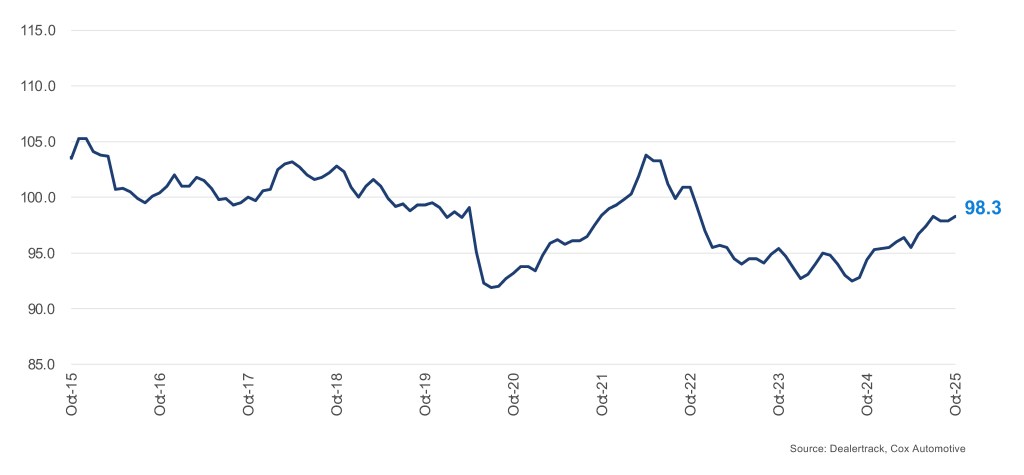In October 2025, the Dealertrack Credit Availability Index resumed its upward trend of improved credit access after a slight tightening in the previous month. The All-Loans Index edged up to 98.3 in October from 97.9 in September, marking a 0.4-point increase month over month and up 4.1% from October 2024. Even though some key metrics varied, this continues the broader run of loosening credit conditions that began in late summer 2024.
Dealertrack Credit Availability Index

Key Metrics
- Approval Rates: The approval rate for auto loans dropped to 72.6% in October, down 1.4 percentage points from September, but up 50 basis points (BPs) from October 2024 (72.1%). While approval rates declined in October, this was offset by increases in subprime lending, longer loan terms, and reduced down payment requirements, which collectively expanded access for borrowers.
- Subprime Share: The share of loans to subprime borrowers increased by 90 basis points (BPs) month over month (from 14.2% to 15.1%) and is up 240 BPs year over year. This change suggests lenders are expanding access to higher-risk borrowers as overall credit loosens.
- Yield Spread: The yield spread widened by 12 BPs (from 7.24 to 7.36), while the average contract rate rose by 11 BPs (from 10.90% to 11.01%). The 5-year Treasury yield fell by 1 BP (from 3.66% to 3.65%). While this widening spread represents less favorable pricing for consumers, it reflects lenders’ willingness to extend credit to riskier borrowers.
- Loan Term Length: The share of loans with terms greater than 72 months increased by 70 BPs (from 26.8% to 27.5%) and is up 300 BPs year over year. This may reflect greater affordability pressures or lender flexibility on term length.
- Negative Equity Share: The proportion of borrowers with negative equity rose by 20 BPs month over month (from 54.0% to 54.2%) and is up 110 BPs year over year. This signals some increase in risk but remains below the highs seen earlier in the year.
- Down Payment Percentage: The average down payment percentage declined by 20 BPs (from 13.5% to 13.3%) and is down 70 BPs year over year. This may indicate increased consumer demand or lender flexibility.
Channel and Lender Trends
- Channels: Credit access improved across most sales channels in October. The largest gains were seen in the non-captive new segment, followed by all new and franchised used. Certified pre-owned (CPO) also saw a notable increase, while all used remained relatively stable and independent used dropped slightly. These gains suggest broad-based loosening, with franchised used showing the most improvement from last year.
- Lender Types: Lender performance was all positive in October. Captives led the improvement, with credit availability rising by 2.1%, reflecting a strong appetite for growth and increased willingness to extend credit. Banks also showed notable loosening, up 1.9%, while credit unions and finance companies posted a 1.0% increase. Overall, lenders are showing more willingness to extend credit, with captives and banks driving the improvement.
Year-Over-Year Comparison
Compared to October 2024, credit access was looser across most channels and all lender types:
- Channels: The most notable year-over-year improvements were in franchised used and non-captive new, indicating stronger credit availability in both new and used vehicle segments. Independent used also improved, though more modestly. All used, all new, and CPO also saw gains.
- Lender Types: Banks and auto-focused finance companies led the year-over-year loosening, while credit unions also improved. Captives showed a more cautious but still positive stance compared to a year ago.
Implications for Consumers and Lenders
- Consumers: The continued improvement in credit access, especially in franchise used and non-captive new vehicle segments, continues to offer financing opportunities. While approval rates declined, the drop in down payments and more flexible loan terms may enhance affordability. However, consumers should remain mindful of longer loan terms and slightly higher negative equity levels when evaluating loan offers.
- Lenders: The performance across lender types reflects the increased risk appetites and strategic priorities. Finance companies, captives, banks and credit unions all appear to be expanding access. As credit conditions evolve, lenders must balance growth with prudent risk management, especially amid shifting rate environments and consumer behavior.
Overall, the October Dealertrack Credit Availability Index reflected a continuation in the loosening of auto credit conditions. The improvement was driven primarily by lenders’ increased willingness to extend credit to subprime borrowers through longer terms and lower down payments, even as overall approval rates declined. However, this expanded access came with higher yield spreads, meaning consumers paid more for financing compared to prevailing market rates.
The Dealertrack Credit Availability Index tracks six factors that affect auto credit access: loan approval rates, subprime share, yield spreads, loan term length, negative equity and down payments. Reported monthly, the index indicates whether access to auto credit is improving or declining. This typically means that it is cheaper and easier for consumers to obtain a loan or more expensive and harder. The index is published around the 10th of each month.


